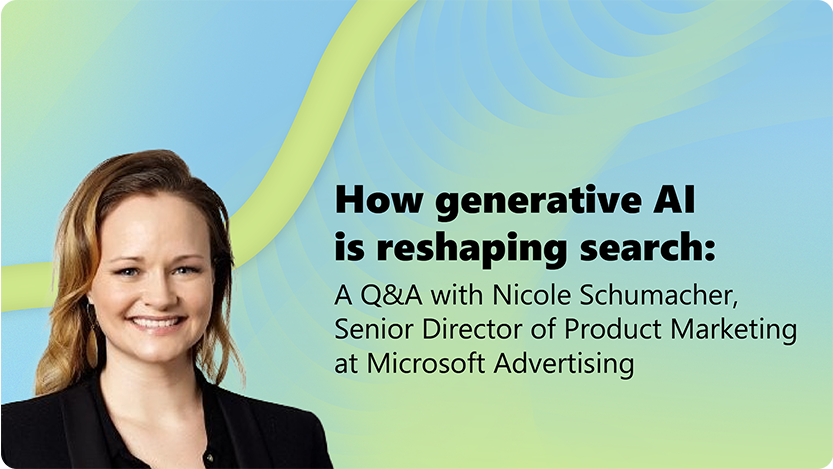Blog post
How generative AI is reshaping search: A Q&A with Nicole Schumacher

The search landscape is shifting rapidly, and generative AI is at the center of it all. To unpack what’s changing, what will remain, and what this means for brands, we sat down with Nicole Schumacher, Senior Director of Product Marketing at Microsoft Advertising. Here’s what she had to say.
1. How is generative AI changing how people search today, and how does that differ from traditional search behavior?
Generative AI is introducing an innovative new way to search, discover, and get things done.
In the past, to search for something, you had to know exactly what you were looking for. You had to be an expert at keywords, briefly describing or distilling what you wanted in one single step to pinpoint your search to practical results. And that can still be valuable. If you know what you’re looking for—like a specific brand, business, movie, or book—traditional search is still great for that and can get you where you want to be quickly.
But what if you can’t remember the name of the thing you're looking for, and you need to describe it more specifically?
Or what if you need more guidance or a conversation to express your needs?
And what if the outcome you’re looking for would be way more valuable if it could be summarized across many different perspectives, like in a table or a synthesized output with reference links?
Generative AI can do all of that. It’s less about specific keyword searches and more about natural language synthesis and multi-step interactions to achieve the desired action or output.
Another way generative AI is changing how people search is in how it feels. Moving to a conversational style gives users a more natural, intuitive, and reassuring experience. There’s a voice on the other end engaging with you, partnering with you, and helping you to achieve what you’re after. It just feels like a different way to receive results and outputs in a language that’s natural to human dialogue. You can also speak to it instead of typing if you prefer. Additional modalities make the experience more engaging and interactive.
2. Search used to be about keywords. Now, it’s more about conversations. What technical innovations are enabling this shift from keyword search to conversational, contextual interactions?
Large language models (LLMs) and complex deep learning algorithms are driving this massive shift we’re seeing in search. How they work is pretty complicated, but the impact of these changes is that we have a far greater understanding of nuance and context from what people are saying.
This allows us to truly understand intent and deliver highly customized results in ways we’ve never been able to before.
For example, imagine someone planning a family vacation. Instead of entering multiple separate search queries, like “kid-friendly resorts in Maui,” “things to do with toddlers in Maui,” and “Maui weather in August,” a user can now ask Copilot a single question, like “Can you help me plan a family vacation to Maui in August for two adults and two kids under five?”
Copilot can synthesize information across the web and respond with a customized plan that includes family-friendly resorts, weather insights, activity ideas, and even relevant travel deals, all in one place, in a single conversational flow.
3. What are some ways Copilot is changing the search experience, and how should marketers think about showing up in those moments in a helpful and relevant way?
Copilot is more than a search tool. It is a trusted AI assistant that can help us learn, plan trips, increase productivity, and so much more. Regardless of how we choose to express ourselves, Copilot can understand complicated or nuanced queries and deliver relevant information.
One of my favorite features is that you can tell Copilot how to format the information, such as with bullets or tables, succinct versus detailed—you name it. And it doesn’t stop there. At the end of the results, Copilot also provides suggestions on next steps and additional ways it can assist you. So it’s super easy to ask detailed questions and receive in-depth responses.
And now that consumers can conduct much deeper research than ever before, brands need to reconsider how to show up in these moments and think beyond keywords. In this world, you must ensure that your content is trustworthy, accurate, and structured, and that it considers a user’s journey and the information they might be looking for in different moments and contexts.
4. What should marketers do now to make sure their ads appear in conversational AI-powered search?
It’s exciting that Copilot is already showing strong advertising results. We’ve seen twice the click-through rates and a 53% increase in purchases when Copilot is part of the user journey—a clear indication that Copilot is guiding users to what they desire, both in content and related ads.
The ads appear below the organic Copilot response, with a conversational summary preceding the ads that explains why the ad is relevant. It creates a clear separation between organic and sponsored content, and there’s value in the connection and context that the Ad Voice, as it’s called, provides. There are fewer, more personalized placements designed to be natural and helpful to the conversation.
Microsoft is now using existing creative assets from search campaigns to bring ads into Copilot. We pull from text-based ads, feed-based ads, and multimedia ads. There are several ways marketers can optimize their appearance in these Copilot results. Visuals enable your ads to stand out more, especially in Copilot, where there are fewer ads than on traditional search engine results pages, or SERPs. Visuals also make ads more compelling and increase their likelihood of being clicked, so formats like multimedia are really effective.
And the best way for your ads to appear in Copilot is by running Performance Max campaigns. These campaigns provide our algorithms with the greatest flexibility to match your product offerings with user intent.
5. With all the buzz around generative AI in marketing, what’s a measurable benefit of AI-powered search that marketers may be underestimating?
This is specific to shopping, but I’m impressed by the 53% increase in purchases when Copilot is a part of the user journey. I think this demonstrates how powerful the experience can be, from browsing products to completing the purchase process, all within a single interaction.
Currently, the consumer funnel and decision-making journey are becoming increasingly shorter and more streamlined. For example, at Cannes Lions 2025 in June, we launched Showroom ads, a brand-new ad format specifically designed for conversational experiences. Consumers can ask their custom questions in a natural conversation instead of hunting for information.
But even more than that, they can enter this showroom and access everything in one place—information from the brand as well as the web. They receive personalized information about a product from both the brand’s perspective and reviews across the web, where they can review and ask questions, all within the same experience. This is an example of a benefit for advertisers that will absolutely be measurable in final outcomes.
6. Microsoft has invested heavily in tools such as Copilot, Performance Max, and Audience Ads. What makes Microsoft’s AI-powered advertising ecosystem stand out in a crowded market, especially from a marketer’s perspective?
Well, the market is less crowded when you consider expertise in search results and search advertising. This leads to the best advertising solutions for these new ways of searching, exploring, and discovering. Our product managers and engineers know how to produce results from queries and, simultaneously, how to maximize the impact of promotional advertising with ads that match the user’s intent. That grounding is an advantage as we build the future of conversational advertising.
I also think we stand out in the breadth of our AI-powered advertising solutions. That includes a variety of campaign types, like you mentioned, from Performance Max to Audience ads, or in the assortment of advertiser productivity tools we’ve built, like those in Copilot and the Microsoft Advertising Platform. Ultimately, you can run many different flavors of campaigns leveraging AI both in your workflow for efficiency and creativity, and in the algorithms used to achieve your outcomes.
7. Looking ahead, how do you see generative AI and search evolving over the next 12 to 24 months?
As we talked about earlier, people are using both traditional search and AI-based chat assistants like Copilot for different purposes. It’s essential that advertisers consider both experiences, as traditional search remains the primary high-volume advertising opportunity today.
The application of generative AI to search advertising will continue to evolve over the next couple of years, focusing on both outcomes and advertiser productivity. Creative personalization will continue to improve, becoming more accessible and applicable to a broader range of formats. The building of audience segments will become more sophisticated with the increasing use of AI applications, and uncovering insights will become faster. Bidding algorithms will continue to improve, particularly with fewer channel-specific advertising campaigns and more outcome-first campaign types, such as Performance Max.
As AI chat assistants like Copilot are increasingly utilized and their use cases expand, conversational advertising experiences will also evolve. Like Showroom ads, we’ll continue to design purpose-built ad formats that maximize the benefits of conversational experiences—whether voice-based, text-based, or other modes. It’s an exciting time.
8. For marketers who are curious about generative AI but not yet fluent, where’s a smart place to begin?
I suggest just jumping into Copilot and asking that question! So, “I’m curious about the basics of generative AI. What can you tell me in three paragraphs?” Or, “I’d like to know a bit about generative AI, particularly how it’s used for advertising. Where should I begin? Can you create a learning journey for me?”
We’ve just published an incredible guide for advertisers to learn all about generative AI and the future of search, so check it out by downloading it here. We also recently hosted a webinar titled, “The New Search Reality: How to Show Up, Stand Out, and Scale with AI.” If you missed it, you can still register to listen back and learn from our experts as they discuss the era of search advertising.
And if you’re new to Microsoft Advertising, take advantage of a free consultation with our team of experts to help you set up an account or get started today.
Your input makes us better
Take our quick 3-minute survey and help us transform your website experience.




